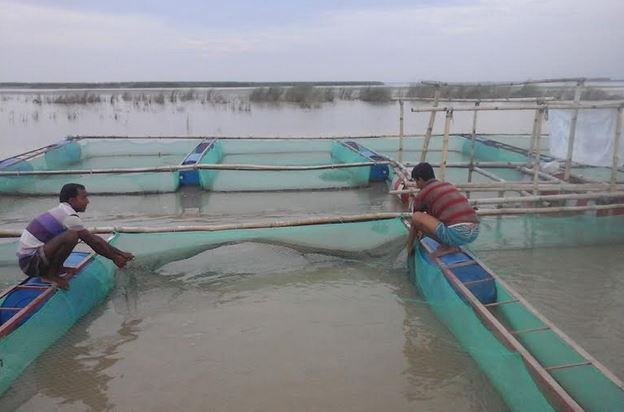
By Aynal Haque
RAJSHAHI, Sept 18, 2022 (BSS) - Shafiul Alam Mukta, a fisherman of Pirijpur village under Godagari Upazila, along with some of his boyhood friends founded a fish sanctuary near his village on an experimental basis in 2014.
Forty other young men of the area also extended their hands with them making their venture laudable.
Within the following couple of years, they attained success in this field as they, so far, found 85 native fish species in the surrounding river areas. Mukta has now established a large fish sanctuary in the river Padma.
They motivated local fishermen to abstain from fishing any sort of fish from that captive water body for eight months.
Amid the banning of catching fish from the sanctuary for eight months, a large number of fish of various local species breed there and fishermen of adjacent water bodies started to catch varieties of endangered and rare species of fish from there.
The sanctuary has started contributing a lot towards protecting and conserving the small indigenous fish species from further degradation in the Padma river and its tributaries for the last couple of years.
Mukta told BSS that fishing at the sanctuary with nets is prohibited but anyone can catch fish there through using fishing rods or fishing wheels.
Moreover the fishes which were supposed to be extinct from the region for a long time were also seen to roam at the sanctuary. There are also a large number of Hilsa fish as well.
Shafiul Mukta is now very happy over his cage fish farming as it changed his fate and made him self-reliant. "I have sold 30,000 kilograms of fish produced from 37 cages and made profits of Taka three lakh," he said.
Many more youths of the village got profit after being farmed of fish in cages in the nearby Padma River.
Mukta said: "We have a 20-member cooperative society named 'Padma Fish Care' in Pirijpur village. To make the sanctuary effective, cage fish farming had been launched there. Couple of years back, the Department of Fisheries first gave them 20 cages and later added twenty more.
The department also provided them with fingerlings of monosex tilapia for rearing in the cages initiating cage fish farming in the river for the first time. Number of cages has now stood at over 50.
Referring to his personal experience Shafiul Mukta said there is an excellent opportunity of establishing cage fish culture on 30-kilometer water areas there with employment scope of more than 10,000 people side by side with boosting significant fish production.
Prof Nazrul Islam of Department of Zoology in Rajshahi University said Padma feeds water to its 27 branches and tributaries and a lot of rare and endangered fish stocks are being released there from this sanctuary in Godagari.
He mentioned the encouraging youths were working for fish sanctuary without any monetary benefit. They do not have any income from the fish sanctuary.
Cage culture has bright prospects of yielding around 10,000 tonnes of additional fishes valued at around Taka 150 crore only in the region annually. A farmer can easily get neat profits worth Taka 35,000 with primary investment of Taka four lakh in every month, Prof Bidhan Das added.
Meanwhile, fifty more fish sanctuaries are being developed on 30 hectares of water body aimed at protecting fish biodiversity through stocking of native fish fingerlings in the division.
Forty have already been established on 24 hectares of water body under a five-year project titled "Fisheries Development in Rajshahi division" that is being implemented in 65 upazilas of eight districts in the division.
Under the project, 76 fish sanctuaries are reactivated and 74 others are also being reactivated.
Md Kamrul Hassan, Director of the project, told BSS that they have already excavated 58 beels on 11.75 hectares of water body and 22 more will be excavated.
Being implemented by the Department of Fisheries (DoF) at a cost of around Taka 47.47 crore, the project is intended to protect the endangered fish species through establishing fish sanctuaries and renovating the existing ones.